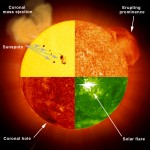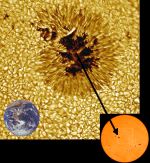The Sun's Face Has Many Features
 Five major solar features are highlighted in this composite of extreme ultraviolet
and visible light images. (Courtesy NASA/SOHO)
Five major solar features are highlighted in this composite of extreme ultraviolet
and visible light images. (Courtesy NASA/SOHO)
- Many times larger than magnetic loops, prominences majestically rise far above the Sunís surface.
- Bright, explosions on the Sun - solar flares - spew high-energy electromagnetic waves (such as X- rays) into space.
- Coronal mass ejections (CMEs) are enormous solar eruptions that blast plasma into space.
- Small, dark regions on the Sunís surface, called sunspots, contain strong magnetic fields.
- Dark coronal holes are portals through which the fastest solar wind escapes from the Sun.
Sunspots
 Sunspots
are relatively dark patches on the Sunís bright surface. These regions
of concentrated magnetic fields can last from several hours to several
months. They appear as dark spots because theyíre cooler (4000įC) than
the Sunís surrounding surface (6000įC). Sunspots tend to develop in groups,
with some covering areas 20 times the diameter of Earth. This visible
light image reveals many sunspots that appear as dark spots on its surface.
(Courtesy NASA/SOHO) Close-up photo of a sunspot. Earth added to give
size comparison. (Courtesy AURA/NOAO/National Solar Observatory at Sacramento
Peak, NM)
Sunspots
are relatively dark patches on the Sunís bright surface. These regions
of concentrated magnetic fields can last from several hours to several
months. They appear as dark spots because theyíre cooler (4000įC) than
the Sunís surrounding surface (6000įC). Sunspots tend to develop in groups,
with some covering areas 20 times the diameter of Earth. This visible
light image reveals many sunspots that appear as dark spots on its surface.
(Courtesy NASA/SOHO) Close-up photo of a sunspot. Earth added to give
size comparison. (Courtesy AURA/NOAO/National Solar Observatory at Sacramento
Peak, NM)
| |
The Space Weather Center is part of the National Space Weather Program, with funding provided by NASA and the National Science Foundation. | |
|
Copyright © 2000 Space Science Institute, all rights reserved
Comments? Send email to webmaster@spacescience.org.